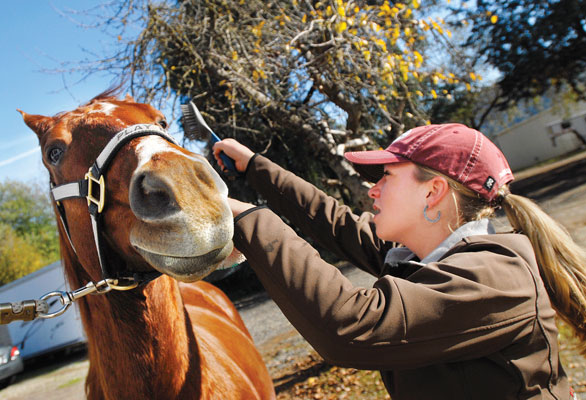
Ever heard of the rodeo event simply referred to as cutting?
Have you tried to describe it?
You have probably watched the intriguing sport once or twice by
accident. Nothing yet?
Now ask 23-year-old Amanda Bettencourt, a Gilroy native and
champion in the sport. Just be prepared because her explanation may
not only generate a smile on the faces of those who listen, but it
just may be convincing enough that a regular person would all of a
sudden want to saddle up a horse – for the first time.
GILROY
Ever heard of the rodeo event simply referred to as cutting?
Have you tried to describe it?
You have probably watched the intriguing sport once or twice by accident. Nothing yet?
Now ask 23-year-old Amanda Bettencourt, a Gilroy native and champion in the sport. Just be prepared because her explanation may not only generate a smile on the faces of those who listen, but it just may be convincing enough that a regular person would all of a sudden want to saddle up a horse – for the first time.
“It is amazing,” said Bettencourt, with a sense of pride and tone of voice that only reaches that level of volume and excitement while singing Happy Birthday or winning the lottery. “It’s the best ride you can ever have in your life. There’s nothing in life that feels as fun. The rush is amazing. It’s extremely addictive.”
Bettencourt doesn’t spare any details, and her enthusiasm rarely subsides as she tells story after story about the sport that has participants competing all over the world.
Cutting is an equestrian event that challenges riders to first separate a bull from its herd, then keep it from returning to the rest of the cattle. That process is repeated three to four times per run, which lasts for two and a half minutes, and the performance is judged at the end.
The visual it produces can be compared to a linebacker in football trying to prevent a running back from getting into the end zone.
The process of horse cutting began back in the 1800s, when cowboys would use their cutting horses to remove a cow from the rest for various purposes, such as medical procedures or sorting.
A necessity in the open range soon became a competition. In 1946 the National Cutting Horse Association was formed and organized events with prize money awarded to the top participants.
The activity, written on paper, may seem trivial. But once exposed to the agility of the horse and the ability of its rider to control the animal, a greater appreciation emerges, and the true beauty of the sport is revealed.
“I had a pony when I was a kid,” Bettencourt said, “and my mom’s co-worker had a friend who was into cutting horses and I went out to ride with her a couple times. I just fell in love with it.”
During her senior year at Gilroy High in 2004, Bettencourt squeezed weekend practice time with her horse trainer M.G. Brown, all the while staying obedient to her parents’ “strict” rules of keeping academics at the forefront.
“He helped me train my horse and taught me to be the rider that I am,” Bettencourt said of Brown.
Bettencourt graduated from GHS in 2004 and enrolled at Gavilan College, where she continued to balance her schooling with the pursuit of her cutting horse passion.
“I showed for years just at local club shows,” Bettencourt said. “It’s competitive but it’s nothing like the NCHA (National Cutting Horse Association). It’s competitive, but I was winning every year. When you can get good at the club level you can step up to the NCHA, so I did that. But it was terribly tough and I kept getting beat.”
Through her own efforts and accountability, and over the course of five years of training and traveling the greater Western portion of the United States, Bettencourt has established herself as one of the best horse cutters over the past year.
Her string of successful shows began at an event in Santa Rosa last December. Entered in four classes, Bettencourt won three of those and placed second in the other, increasing her confidence and fueling her competitive spirit.
“I had never won a lot at the big shows and it’s kind of intimidating and a step up,” she said. “Once I won that one it kind of came easier. My horse was better and I knew I had a good horse.”
Bettencourt’s persistence and dedication paid off. And with a competitive edge her aunt Debby Kline said she has possessed since she was young, Bettencourt, with her horse Play Royal, rode her way to Rookie of the Year of the Pacific Coast Cutting Horse Association and the top spot in the $20,000 non-pro division, which means she entered the year having earned less than $20,000.
“She is just really focused,” Kline said, wiping tears away from her cheek. “She always had been. It’s pretty amazing.”
In addition to those achievements with the prize money she racked up over the last year, Bettencourt finished 2009 in the top 15 of the NCHA world rankings in both the $20,000 non-pro (4th) and the $10,000 amateur (6th).
Bettencourt said she may take a little time off from competition to concentrate on a dental hygiene degree, but also made it very clear that horse cutting will remain a large portion of her life.
“This is my plan,” Bettencourt said matter of factly. “I’m just going to live here at home, clean teeth four days a week and show my horses Friday, Saturday and Sunday. I’m going to spend all my money on horses. I know it sounds ridiculous, but I love it.”









